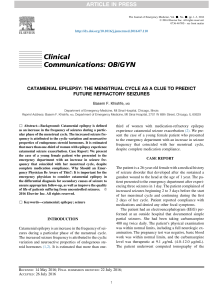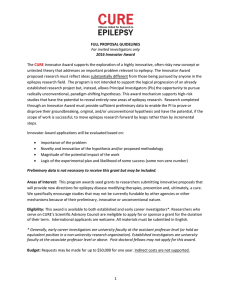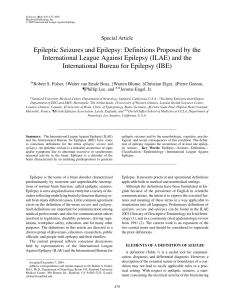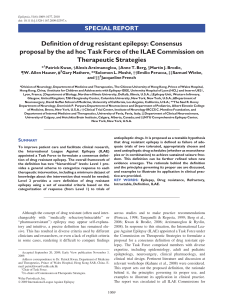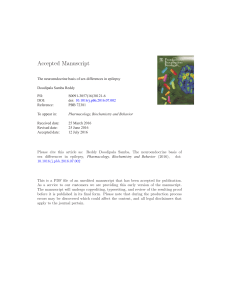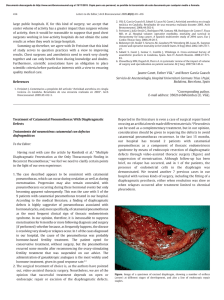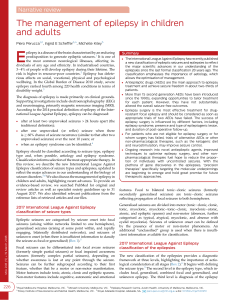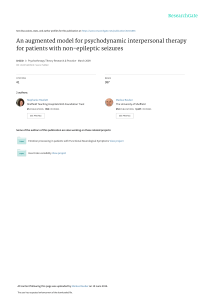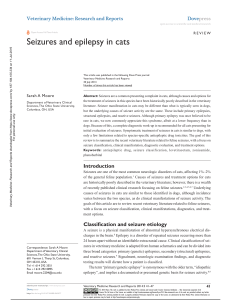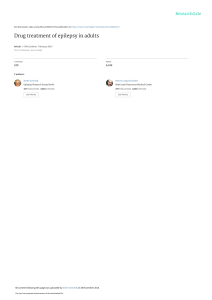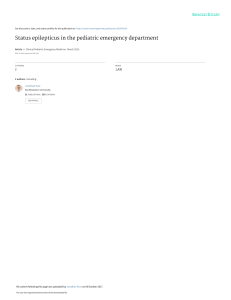Catamenial epilepsy A missed cause of refractory seizure in young women
Anuncio
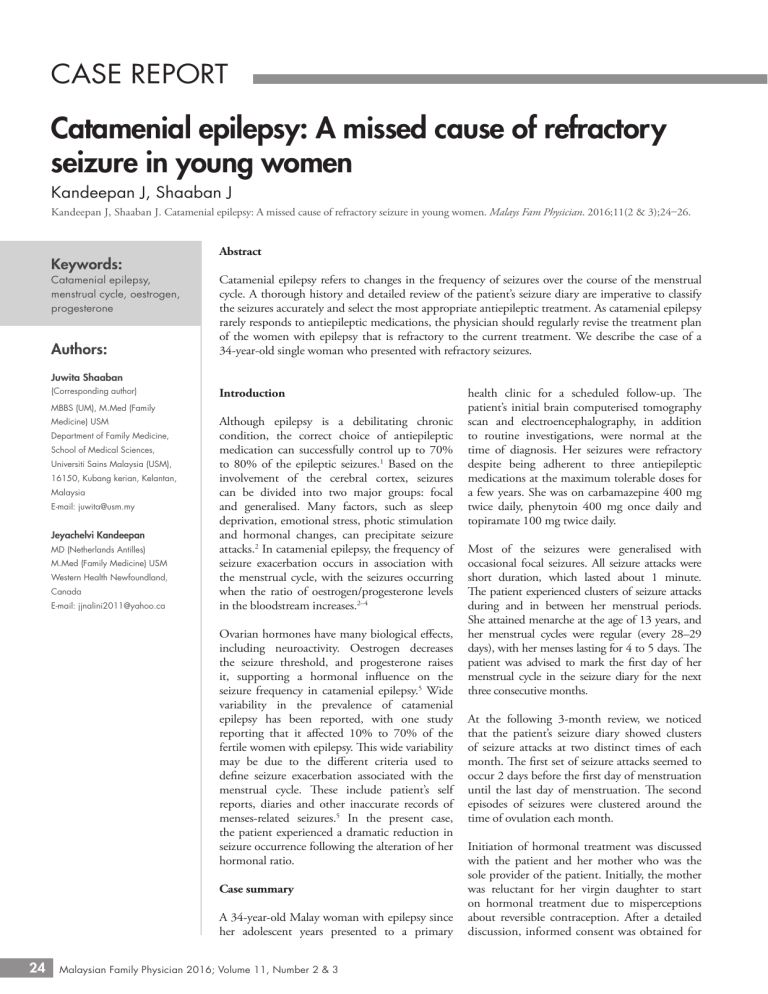
Case Report Catamenial epilepsy: A missed cause of refractory seizure in young women Kandeepan J, Shaaban J Kandeepan J, Shaaban J. Catamenial epilepsy: A missed cause of refractory seizure in young women. Malays Fam Physician. 2016;11(2 & 3);24–26. Keywords: Catamenial epilepsy, menstrual cycle, oestrogen, progesterone Authors: Abstract Catamenial epilepsy refers to changes in the frequency of seizures over the course of the menstrual cycle. A thorough history and detailed review of the patient’s seizure diary are imperative to classify the seizures accurately and select the most appropriate antiepileptic treatment. As catamenial epilepsy rarely responds to antiepileptic medications, the physician should regularly revise the treatment plan of the women with epilepsy that is refractory to the current treatment. We describe the case of a 34-year-old single woman who presented with refractory seizures. Juwita Shaaban (Corresponding author) Introduction MBBS (UM), M.Med (Family Medicine) USM Department of Family Medicine, School of Medical Sciences, Universiti Sains Malaysia (USM), 16150, Kubang kerian, Kelantan, Malaysia E-mail: [email protected] Jeyachelvi Kandeepan MD (Netherlands Antilles) M.Med (Family Medicine) USM Western Health Newfoundland, Canada E-mail: [email protected] Although epilepsy is a debilitating chronic condition, the correct choice of antiepileptic medication can successfully control up to 70% to 80% of the epileptic seizures.1 Based on the involvement of the cerebral cortex, seizures can be divided into two major groups: focal and generalised. Many factors, such as sleep deprivation, emotional stress, photic stimulation and hormonal changes, can precipitate seizure attacks.2 In catamenial epilepsy, the frequency of seizure exacerbation occurs in association with the menstrual cycle, with the seizures occurring when the ratio of oestrogen/progesterone levels in the bloodstream increases.2–4 Ovarian hormones have many biological effects, including neuroactivity. Oestrogen decreases the seizure threshold, and progesterone raises it, supporting a hormonal influence on the seizure frequency in catamenial epilepsy.5 Wide variability in the prevalence of catamenial epilepsy has been reported, with one study reporting that it affected 10% to 70% of the fertile women with epilepsy. This wide variability may be due to the different criteria used to define seizure exacerbation associated with the menstrual cycle. These include patient’s self reports, diaries and other inaccurate records of menses-related seizures.5 In the present case, the patient experienced a dramatic reduction in seizure occurrence following the alteration of her hormonal ratio. Case summary A 34-year-old Malay woman with epilepsy since her adolescent years presented to a primary 24 Malaysian Family Physician 2016; Volume 11, Number 2 & 3 health clinic for a scheduled follow-up. The patient’s initial brain computerised tomography scan and electroencephalography, in addition to routine investigations, were normal at the time of diagnosis. Her seizures were refractory despite being adherent to three antiepileptic medications at the maximum tolerable doses for a few years. She was on carbamazepine 400 mg twice daily, phenytoin 400 mg once daily and topiramate 100 mg twice daily. Most of the seizures were generalised with occasional focal seizures. All seizure attacks were short duration, which lasted about 1 minute. The patient experienced clusters of seizure attacks during and in between her menstrual periods. She attained menarche at the age of 13 years, and her menstrual cycles were regular (every 28–29 days), with her menses lasting for 4 to 5 days. The patient was advised to mark the first day of her menstrual cycle in the seizure diary for the next three consecutive months. At the following 3-month review, we noticed that the patient’s seizure diary showed clusters of seizure attacks at two distinct times of each month. The first set of seizure attacks seemed to occur 2 days before the first day of menstruation until the last day of menstruation. The second episodes of seizures were clustered around the time of ovulation each month. Initiation of hormonal treatment was discussed with the patient and her mother who was the sole provider of the patient. Initially, the mother was reluctant for her virgin daughter to start on hormonal treatment due to misperceptions about reversible contraception. After a detailed discussion, informed consent was obtained for Case Report a trial of intramuscular medroxyprogesterone 150 mg, which was administered via 10 weekly injections. At the 10th week followup, the numbers of seizure attacks showed a marked decrease from 15–20 to 3–4 attacks per day. Discussion Catamenial epilepsy is defined as a periodical increase in seizure episodes during the menstrual period.3 Based on the timing of seizure exacerbation during the different phases of the menstrual cycle, catamenial epilepsy is classified as perimenstrual (ovulatory cycle), periovulatory (ovulatory cycle) or luteal (anovulatory cycle). Women with epilepsy whose seizure attacks are more frequent during one of these three phases should be diagnosed with catamenial epilepsy.6 In the present case, the seizures were refractory to treatment as it persisted despite three antiepileptic drugs administered at maximum tolerable dosages.7 When a seizure seems to be refractory to treatment, the physician need to evaluate many factors including whether the epilepsy was classified incorrectly or the patient was treated with an incorrect antiepileptic drug.8 A review of the patient’s seizure diary revealed that the frequency of the seizures increased during the ovulatory and perimenstrual periods; hence, the possibility of catamenial seizures needs to be considered. Studies have confirmed that catamenial seizures are usually not responsive to antiepileptic drugs alone. To date, there is no specific drug treatment for catamenial epilepsy. However, non-hormonal and hormonal therapies have been proposed.3,4 Among the non-hormonal treatments, acetazolamide, a carbonic anhydrase inhibitor, showed some effectiveness against catamenial epilepsy, although its efficacy diminished over time, and tolerance developed.5 Similarly, treatment with clonazepam, an intermediate-acting benzodiazepine, led to a reduction in seizure frequency in catamenial epilepsy. However, long-term use of clonazepam can lead to dependency and tolerability.5 Among the hormonal treatment, several studies reported that a trial of either oral cyclical progesterone or intramuscular medroxyprogesterone injections resulted in a reduction and remission in seizures. When using the cyclical progesterone, high oral progesterone doses of 600 mg/day can be given from day 16 to 25 of the menstrual cycle. It is a better treatment choice for patients with anovulatory luteal phase catamenial epilepsy.3 Zimmerman et al.9 reported that three doses of intramuscular Depo-Provera (medroxyprogesterone) two weekly at 250, 250 and 150 mg led to remission of seizures for 4 months. Thereafter, the seizures returned, but their frequency was markedly reduced. In this patient, the seizures were associated with ovulation and peri-menstruation; intramuscular medroxyprogesterone injections were administered to keep the progesterone/ oestrogen ratio high in the entire cycle. The injections were administered 10 weekly as she was also on an enzyme-inducing antiepileptic drug, carbamazepine which can affect the progesterone level.10 It was not an easy task to suggest contraception to an unmarried woman or to change the woman’s perception of contraception as an antifertility drug. Najafi et al.11 confirmed a similar misconception in a study of well-educated Malaysian women. In their study, all the interviewees had misconceptions about contraception and fertility. These misconceptions were based on their own experiences and those of their peers.11 The present case was no exception. However, after a lengthy explanation, we were able to convince our patient and her mother about the value of taking the hormonal injection. A key element of the family physician’s role in chronic disease care is ‘healing’ the patient, as well as managing the disease.12 Epilepsy management is not about eliminating risks, but helping individuals reduce these risks while living a normal life and carrying out daily activities. This case demonstrates that the physicians have to be more vigilant and should not hesitate to revise the diagnosis and re-evaluate the treatment plan when seizures are refractory to treatment. A prompt re-evaluation will reduce unnecessary suffering and improve the quality of life of the patient. Diagnosing the type of seizure is challenging for most physicians, as they rarely witness their patient’s seizure. Unfortunately, the patient cannot be a historian. Therefore, the detailed history from the eyewitness is imperative to diagnose the type of seizure. An accurate diagnosis is important because the type of Malaysian Family Physician 2016; Volume 11, Number 2 & 3 25 Case Report seizure influences the choice of medication. Conclusion Catamenial epilepsy is relatively common. A seizure diary is imperative in the management of epilepsy, and the physician should re-evaluate patients when the seizures fail to respond to optimum treatment. In women with epilepsy, catamenial epilepsy should be considered in the diagnosis when the seizures are refractory. References 1. 2. 26 Lua PL, Neni WS, Samira TN. Coping with epilepsy: how do they influence: health-related quality of life (HRQoL). Int J Psychosoc Rehabil. 2012;16(1):17–32. Available at: http://www. psychosocial.com/IJPR_17/Coping_with_ Epilepsy_Lua.html. Accessed November 11, 2016. Kammerman S, Wasserman L. Seizure disorders: part 1. Classification and diagnosis. West J Med. 2001;175(2):99–103. 3. Herzog AG. Catamenial epilepsy: current concepts of definition, prevalence pathophysiology, and treatment. Z Epileptol.2015; 28(4):295–303. 4. Najafi M, Sadeghi MM, Mehvari J, et al. Progesterone therapy in women with intractable catamenial epilepsy. Adv Biomed Res. 2013;2:8. Available at: http://www.ncbi.nlm.nih.gov/pmc/ articles/PMC3732888/. Accessed November 11, 2016. 5. Verrotti A, D’Egidio C, Agostinelli S, et al. Diagnosis and management of catamenial seizures: a review. Int J Women’s Health. 2012;4:535–41. 9. 6. El-Khayat HA, Soliman NA, Tomoum HY, et al. Reproductive hormonal changes and catamenial pattern in adolescent females with epilepsy. Epilepsia. 2008;49:1619–26. 10. Reddy DS. Clinical pharmacokinetic interactions between antiepileptic drugs and hormonal contraceptives. Expert Rev Clin Pharmacol. 2010;3(2):183–92. 7. Beleza P. Refractory epilepsy: a clinically oriented review. Eur Neurol. 2009;62:65–71. Available at: www.ncbi.nlm.nih.gov/pubmed/19521080. Accessed November 11, 2016. 11. Najafi FSA, Rahman HA, Juni MH. Barriers to modern contraceptive practices among selected married women in a public university in Malaysia. Glob J Health Sci. 2011;3(2). 8. Ismail MHIH, Phak NH, Thomas T. Pediatric Protocol for Malaysian Hospital. 3rd ed. 2012. Available at: http://mpaweb.org.my/ Accessed November 11, 2016. Malaysian Family Physician 2016; Volume 11, Number 2 & 3 Zimmerman EA, Holden KR, Reiter EO, et al. Medroxprogesterone acetate in the treatment of seizures associated with menstruation. J Pediatric. 1973;83:959–63. 12. Martin CM. Chronic disease and illness care: adding principles of family medicine to address ongoing health system redesign. Can Fam Physician. 2007;53(12):2086–91.
